In July of 1343, a company of English knights, squires, churchmen, and men-at-arms appeared before Algeciras, in southernmost Spain. There they found King Alfonso XI of Castile, who had been besieging the city since the previous summer. Algeciras was an important port city on the Strait of Gibraltar which allowed the emir of Granada to receive reinforcements from Africa. With these augments, the emir posed a serious menace to Castile.
The English were not the only foreigners to show up. News of the siege had spread like wildfire through Christendom—a new expedition against the infidels. The Crusades had ended two generations earlier, but the crusading spirit had not entirely died. The current crop of knights had been raised on their grandfathers’ stories of the wars in Outremer, which they held as embodying the highest chivalric ideal. So when word got out that a Christian prince was undertaking a major new expedition, warriors from all over Europe flocked to southern Spain.
But the English were not there to fight a holy war. Leading them was Henry, Earl of Derby, a relative of the king of England. He had been tasked with an important diplomatic mission: Genoese ships in French employ had devastated the English coast during the recent fighting, and the English could use allies of their own. Would the Castilian monarch be interested in loaning his powerful navy? To show their good faith, the embassy decided to aid the king in his own war.
The siege had been held up by the ring of suburbs surrounding the city walls. The forces within used these as extended fortifications, from which they could snipe and harass the Castilian army. Alfonso decided they must be dealt with, and sent a force to clear them out. The Spanish forces were soon cut off, and Alfonso asked Henry for help; Henry and his men charged in after the isolated Christians, giving them an opening to escape.
The Moors took to flight and Sir Henry pursued, chasing them through the narrow suburban streets. Soon, he and a small contingent realized they had become separated from the others. Muslim warriors surrounded them from all sides, closing in as they fired arrows and thrust their lances. Most of the knights had already returned to the siege lines, leaving Henry, his friend the Earl of Salisbury, and a handful of others entangled in the swarm. Most of them were experienced knights, veterans of the recent war in France. But there was also a squire, barely out of boyhood, who nevertheless fought with a ferocity worthy of a man. More than once, he struck down a Granadan soldier coming for Sir Henry.
When Alfonso realized how desperate the situation was, he ordered the entire siege line forward out of their entrenchments. The charge forced the Muslims back into the city walls, and the assailed English were able to make it to safety. Back in camp that evening, the squire who had fought so valiantly was the toast of the evening feast. He received the acclaim with such grace and humility that many remarked what a fine knight he would someday be.
Most of this episode is entirely historical. King Alfonso fought a long war with the Moors beginning in 1340 and was aided at the siege of Algeciras by the Earl of Derby, who was very nearly killed during the fighting described above. Only the squire is fictional. He is a fanciful reconstruction of one of medieval literature’s most memorable characters: the knight from Geoffrey Chaucer’s Canterbury Tales.
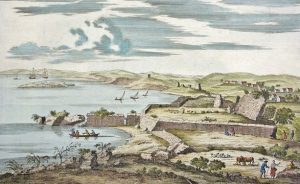
The adventures of Chaucer’s knight give us a fascinating tour of Europe and the Mediterranean in the 14th century. He is a mute guide through the convoluted politics, brutal wars, and religious zeal of the age. His travels also show us how interconnected the small elite of Europe was at the time, even across distances of thousands of miles. The knight’s far-ranging career took him across Europe, Asia, and Africa, where he participated in all the major actions of the day.
But Chaucer’s knight would not see the capture of Algeciras: the Earl of Derby concluded his business after a couple months and was back in London by September. It was there, probably that same year, that the knight’s creator was born.
The Birth of Chaucer’s Knight
Geoffrey Chaucer was born into a middle-class family, but spent his entire career among royalty and high nobility. His work took him across Europe and introduced him to the foremost figures of the age: Edward III, Richard II, John of Gaunt, and John Hawkwood, literary figures such as Petrarch, Froissart, and possibly Boccaccio, not to mention countless humbler people of the sort that fill the pages of the Canterbury Tales.
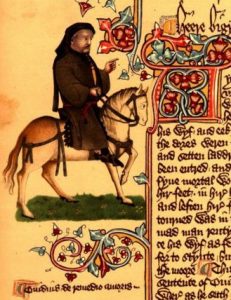
His career began early. Young Geoffrey became a page in the household of the Duke of Clarence, a younger son of King Edward III and thus one of the most important men of the realm. With such connections and with his remarkable ability, Chaucer soon won himself high position in the English civil service. In 1374, he was assigned to oversee the collection of customs for the port of London, which put him in contact with people arriving from all parts of Europe and the Mediterranean. The countless travelers’ tales and descriptions far-off lands he heard almost certainly made their way into his writing (there is a long tradition of customs officials going on to create important literary works).
Chaucer’s talents also marked him for special service to the Crown. He was sent on several diplomatic and espionage missions that took him to Flanders, France, Spain, and twice to Italy. Nor was he confined to courts and government offices: Chaucer fought in several campaigns during the Hundred Years’ War, beginning as a teenager in the Duke of Clarence’s entourage.
All of these experiences gave Chaucer material for his remarkably fruitful literary career. He was a keen observer and knew how to paint nuanced portraits with a few strokes of the pen, subtle allusions that were readily grasped by his urbane audience. Chaucer’s knight is just one of these rich characters whose details give us a sweeping view of the 14th-century world. What can we see?
The Description of the Knight
Chaucer’s knight is introduced in the General Prologue to the Canterbury Tales. Below is a very literal, line-by-line translation (my own) of his description:
What kind of man was this knight? The list of his deeds alone shows him to have been an active man, one who spent his entire life in the saddle. Let us look at his appearance first, which tells us about his hard-riding life:
Of fustian he wored a gypoun,/ Al besmotered with his habergeoun;/ For he was late ycome from his viage,/ And wente for to doon his pilgrymage.
He wore an over-garment of fustian [a type of rough cloth], which had been stained by the rust or grease from his coat of mail. He had just returned to England from his adventures, and went straight on pilgrimage before even returning home.
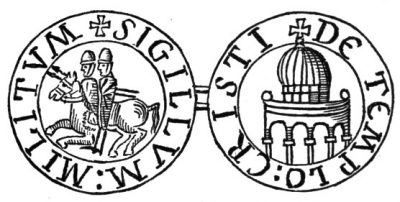
In other words, a poor appearance for one of his station. But poverty of a sort could be a sign of virtue for the upper classes in the proper context. Templar iconography often depicted two knights astride a single horse, emphasizing their willingness to fight despite extreme privation. Beyond the virtues associated with his appearance is the sense that the knight is first and foremost a man of action: he has come straight from war, not bothering with finery.
The great historical backdrop to all this was of course the Hundred Years’ War. It had broken out between England and France in 1337. The opening phase of the war saw a vast number of English soldiers called up to serve in France. Medieval warfare could be very profitable for these medieval levees. Most of the English actions during this period of the war consisted of ravaging the French countryside, which reaped great spoils at little risk.
The war progressed fitfully over the next century, with several lengthy truces and peace treaties made throughout. Deprived of income by the peace, many Englishmen set off for foreign lands to find work as mercenaries. They would make their way to Spain, Italy, and other places where opportunities abounded. Chaucer’s knight was among those who fought in the Hundred Years’ War itself (his lorde’s werre) as well as many other foreign lands. The General Prologue mentions no fewer than ten different places he visited, and implies a great number more.
If the number of distant places the knight visited is astonishing, even more so is the length of time he must have spent on campaign. Between his time overseas and his service in France, he must have spent the majority of his years in the saddle. This is remarkable but not unheard of: there are many men in history who became so accustomed to life in the camp that they spent their entire lives at war. Even today there are many reservists in the American military who activate for deployment after deployment, staying minimally employed between stints overseas.
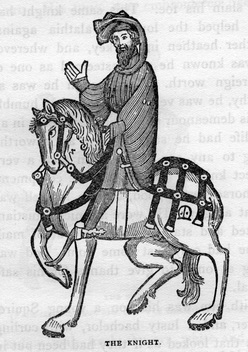
Chaucer’s knight had been so many places that he could easily be a composite of several figures, a caricature of the knight errant. But many knights of the 14th century were surprisingly well-traveled, as we will see: it is entirely possible that this was a real person. The timing certainly works out: the foreign expeditions that can be given a firm date coincide exactly with breaks in the Hundred Years’ War.
What associations would a 14th-century audience hold for those knights who campaigned all around Europe and the Mediterranean? They were a mixed lot to be sure, containing the highest nobility in search of honor to poor knights looking to make their fortune. Some of these latter men could be ruffians, which is why Chaucer took pains to emphasize that his knight was not a mere pirate. His excellent manners make clear that whatever rough-living he endured, he lived up to the highest ideals of his time.
At the Seege of Algezeer
The Earl of Derby and his household were examples of honorable knights who went to fight abroad. Chaucer would have had special insight into this episode: as a boy, he was a page to the Duke of Clarence, who had been at the siege as a young man. The warrior nobility of Europe was a small world. The long list of battles and sieges at which they had been present were part of the common idiom spoken at feasts, tournaments, and hunts.
Algeciras had a particular significance in this world For the past century, there had been relatively little fighting in Spain. The Reconquista was largely complete by 1250, and Muslim territory in the Iberian Peninsula was reduced to the rump state of the Emirate of Granada, which would endure for the next two and a half centuries. This sole remaining Muslim power was subjected to tributary status by Castile. Peace broke down on several occasions, during which Castile always chiseled off another sliver of Granadan territory. But these were border skirmishes: no significant territory would change hands until the Granada War, when Ferdinand and Isabella expelled the Moors for good.
The recent round of hostilities was prompted by the rise of a new power in Morocco. This dynasty, called the Marinids, or Banu Marin, invaded Spain in an attempt to shore up the woeful position of Islam there. Two other North African dynasties, the Almoravids and the Almohads, had done the same in recent centuries, sending invasion forces across the Strait of Gibraltar. Those two had succeeded in temporarily pushing the Christians back; this time, a coalition of Spanish kingdoms decisively checked the invaders early on, forcing the Marinids back across the straits. That left Granada alone to face the wrath of Castile.
Into Heathenesse
In Gernade at the seege eek hadde he be/ Of Algezir, and riden in Belmarye/….And foughten for oure feith at Tramyssene/In lystes thries, and ay slayn his foo.
What of Belmarye and Tramyssene? The first refers to the land of the Banu Marin, which is to say the Marinids of Morocco. The second is usually interpreted as Tlemcen, in western Algeria; both lines are difficult to interpret.
The most obvious interpretation of riden in is context is to ride out on a military expedition. But the Christians did not raid in Marinid lands during this period, so the conventional interpretation is that Chaucer’s knight, after having just fought against the Muslims, went and found employment with them, as a mercenary.
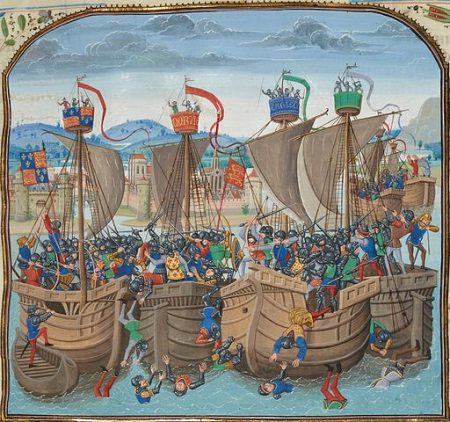
There is another explanation that makes more sense. Another meaning of the Middle English verb ride is to sail on a ship. In this context, it is perfectly appropriate: while Algeciras was besieged, some Castilian forces undertook an abortive naval expedition against the Marinid fleet anchored off Ceuta which did not ultimately engage the enemy ships. The Earl of Derby participated, however, meaning Chaucer’ knight probably would have too.
But let us entertain the thought that Chaucer intended the more ordinary meaning of riden and that the conventional interpretation is correct. What sense can we make of this, and what does it show us of the 14th-century world? This would be the first time Chaucer’s knight could be honoured for his worthynesse in Heathenesse.
North Africa
The Marinids were in power because they had overthrown an earlier dynasty, the Almohads, a century before. Part of the reason for their success was a large contingent of Christian mercenaries. These soldiers, called farfanes, came mostly from Aragon or other parts of the Iberian Peninsula. From the Christian point of view, there was not much to reconcile with their beliefs. As long as they were fighting against Muslims, it was excusable if they also happened to be fighting alongside some Muslims.
From the Muslim point of view, necessity dictated the action. The Marinids had especial need of good troops because they were just beginning to conquer and absorb their neighbors. They captured Tlemcen in 1337, then Tunis ten years later. If Chaucer’s knight did in fact enter Marinid service during this time, he would have fought in eastern Algeria and modern Tunisia.
Tlemcen is thought by most scholars to be Tramyssene, but that is one of the more mysterious references in the knight’s exploits. If Chaucer’s knight fought in Tunisia in the service of the Marinids, then it is quite possible he passed through there en route to the wars in Tunisia. While there, he would have fought in some contest over religion, resembling a joust, where he slew three opponents.
Would this have been a European innovation, introduced to the Muslim world by the farfanes? Perhaps. There is also a native Muslim tradition of jousting, practiced as part of the equestrian martial arts known as furusiyya. At any rate, the jousts in Tlemcen were different from those in Europe, as Chaucer’s knight killed all three of his opponents—that was not thought honorable in Europe.
As we will see later, though, Tramyssene may not be anywhere near Tlemcen.
A Northern Crusade
The Castle of Marienburg is an enormous, sprawling complex made of brick and topped with red tiles. Blanketed with the first snows of the northern winter, its brightly-colored masonry is all the more striking. Smoke emerges from the several chimneys that poke up through the roof of the Knight’s Hall, where a crowd of hundreds is packed in. Great platters of flesh and fowl are ferried in a continuous stream from the kitchens, accompanied by tankards brimming with ale.
The gathering is made up almost mostly of knights and their squires, along with priests, servants, and their hosts, the brothers of the Teutonic Order. It is an international group, and the serving men hear at least a dozen languages as they walk among the tables. In a few days, the lot of them will take off on campaign against the heathen Lithuanians, who have been attacking lands belonging to the Teutonic Order.
Packed on the benches of one long table is a group of English knights, recently arrived from France. Laughing and joking, they boast that a ragged group of pagans will be no problem for the victors of Crécy. This riles up a group of French knights, who say the English can only win when they send their peasants off to battle. Things get heated between two of the knights, and it appears as if a brawl is about to break out—but the moment of tension passes, and they all return to laughing and drinking. A few brothers of the Order look on silently, unamused by their guests’ frivolity.
After some time, the Grand Master of the Order stands up to address the gathering. He thanks them for joining their brothers in Christ to fight the pagan, and exhorts them to steel their hearts and minds for what is to come. A prayer of benediction is said over the assembly, then they are left free to drink and carouse into the night.
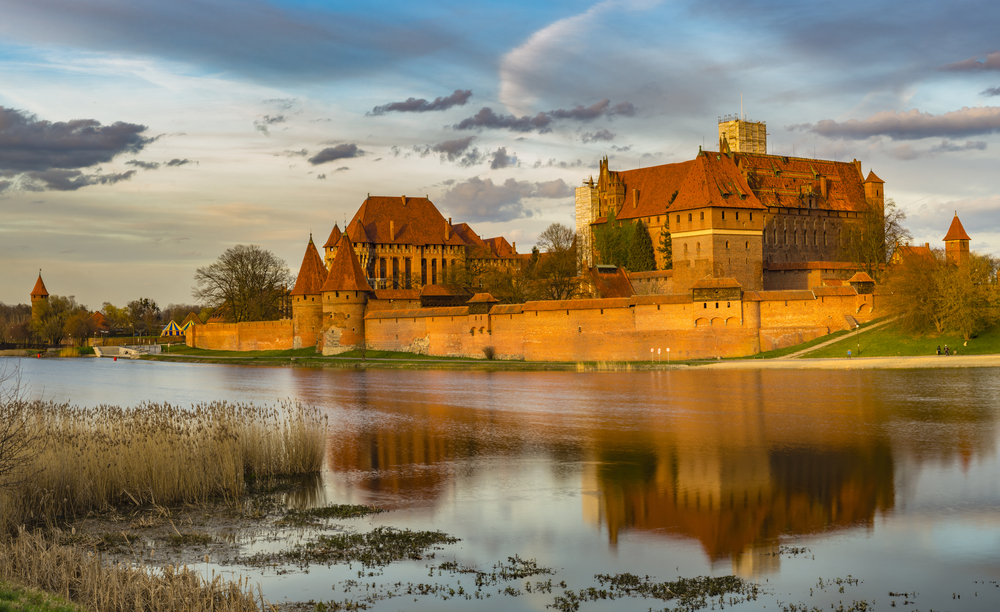
Another truce in the Hundred Years’ War was declared in 1347, giving both sides time to lick their wounds. The timing was fortunate, as the Black Death swept through both countries the next year. Once again there was an exodus of fighting men from France as they went off to seek fortune in foreign lands. A good number of these men wound up in Prussia.
Prussia—modern-day northeastern Poland, along with most of what is now Estonia and Latvia—was under the control of the Teutonic Order. This was an order of monastic warriors, modeled on the Knights Templar and the Hospitallers, which had a papal mandate to conquer those parts of northeastern Europe that were still pagan and convert them to Christianity. Going off to fight with the Order had become a custom among younger European knights, one in which they could prove their worth and earn religious merit. The Teutonic Knights hosted these guests in full state at their magnificent headquarters at Marienburg Castle before taking them out on campaigns in pagan territory.
What does Chaucer’s knight tell us about this time?
In Lettow and in Ruce
Ful ofte tyme he hadde the bord bigonne/ Aboven alle nacions in Pruce;/ In Lettow hadde he reysed, and in Ruce,/ No cristen man so ofte of his degree.

The first half of this says that Chaucer’s knight began the feast at Marienburg, meaning he held the seat of honor: the Order honored thus those who fought hardest or most bravely. The passing allusion to “alle nacions” indicates just how international these affairs were, and how competitive. Honor and reputation were the currency of young knights making a name for themselves, and the battlefields of Lithuania were one place where they could be won.

The second half says that no one went on more expedition in Lettow and Ruce. Chaucer uses a particular word to describe what these expeditions: the knight reysed. This is in fact a German word, meaning to go out on an expedition. In this context, reysas were much like the great chevauchées, or extended cavalry raids, used by the English in the Hundred Years’ War. The Lithuanians were hard to pin down in the sort of full-scale battle that favored western heavy cavalry, so the Knights had to adjust their tactics. They undertook annual winter campaigns into Lithuania, where mobile forces of cavalry would sweep across the frozen landscape. They would sack isolated settlements, seize livestock, and skirmish with any forces they encountered. Beyond the strictly military effect, this put pressure on the local population, which would have their food stocks stripped in the dead of winter—a strong incentive to abandon their pagan chieftains.

Lithuania was continuing to put up a stout resistance by the mid-14th century. The ruler of that state, Grand Duke Algirdas, was a formidable adversary and staunch pagan. He had overthrown his own brother to gain power, then expanded the boundaries of Lithuania in all directions, looking set to overwhelm even territories held by the Teutonic Order. Several raids into Teutonic territory had done enormous damage and taken thousands prisoner, which added an element of urgency to the Teutonic Knights’ situation. Western knights arriving in Prussia might have arrived with a light-hearted sense of adventure, but the brothers of the Order were desperate for their help.
The 1347 truce in France was therefore well timed for the Order, as it released a large body of fighters for the 1348 winter campaign. Unfortunately, the reysa hit bad weather soon after setting off from Marienburg in January. Only a small force was able to continue, which encountered a large Lithuanian army along the River Streva. Trapped between the river and their foes, the men of the Order were forced to fight. In a desperate gamble, the western heavy cavalry managed to break through the lines of enemy infantry, shattering their formations. What should have been a sure Lithuanian victory turned into a rout. The Knights exploited their position to the hilt and ravaged the land all winter.
Such was the fighting Chaucer’s knight would have faced in Lettow. What about Ruce? This reference is a little more obscure. The obvious answer is Rus’, the forerunner to modern Russia. The Holy Roman Emperor granted the Teutonic Order the right to conquer Rus’ in 1337. As long as so formidable an adversary as Algirdas threatened Teutonic lands, there was no hope of making good their claim. There was also less of a religious motivation—Russia had been Christian for centuries, albeit of the Orthodox rite. What then did Chaucer mean by his allusion to Ruce?
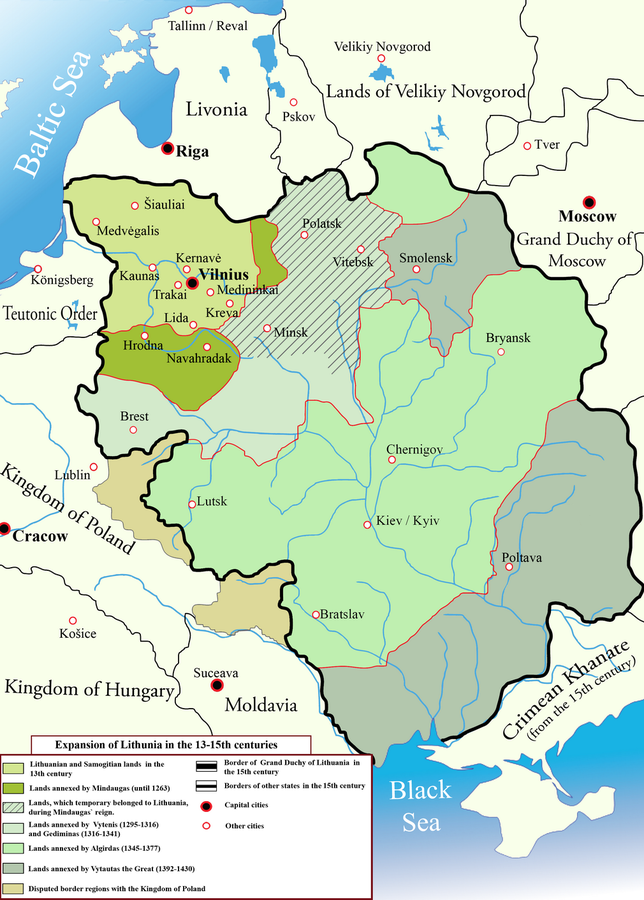
Ruce most likely referred to lands possessed by Lithuania. Algirdas had absorbed several formerly Rus’ principalities, and would eventually expand his territory all the way down to the Black Sea. Rus’ had ceased to be an independent political entity after the Mongol conquest a full century before, and now comprised numerous semi-independent principalities. The word Ruce would have therefore referred to lands occupied by Russian people, including those held by the Grand Duke.
Is there any precise period Chaucer would have imagined his knight reysing in Lithuania? As always, well-connected Chaucer would have known several people who had been to Prussia. The Earl of Derby, by this time had become Duke of Lancaster, visited the Grand Master of the Order at Marienburg during the winter of 1351-52. He did not ultimately participate in a reysa, but would have been accompanied by many who did. If Chaucer’s knight was not already in Prussia at this point, he could have come out with Henry.
Eventually, though, the knight made his way back to France. The truce had broken down in 1355, and all English fighting men were expected to muster. A year later the English won a crushing victory at the Battle of Poitiers, and in 1360 the two sides signed a peace that would last until 1369. This gave Chaucer’s knight a full decade in which he would now make his way around the eastern Mediterranean.
Turkish Wars
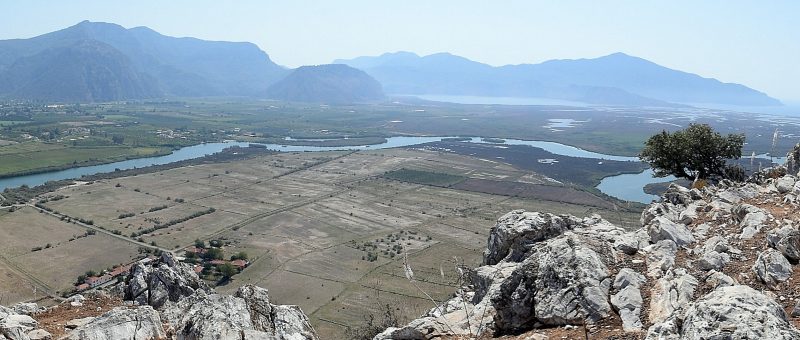
The two armies had been tracking each other for hours. Clouds of dust rising above the dry hills of upland Anatolia let each side know exactly where the other was. Small bands of outriders broke off from the main forces to get eyes on the enemy and harass his exposed elements with flurries of arrows. After several hours of maneuvering and skirmishing under the hot sun, the two sides came face to face over a dry river bed.
The two generals arranged their units on line and began making preparations to attack. After some skirmishing, the main body on each side began to advance. The wings of one of the armies began sweeping out to either side in an attempt to envelop the enemy’s flanks. A gap began to open up between the two halves. Sensing an opportunity, the opposing general ordered his men to push through the weakened center and isolate the two halves.
At this moment a group of men appeared on a ridge overlooking the battle. They looked nothing like the men engaged below: riding large, sturdy horses, they were encased in metal armor and bore long lances. Lined up in close formation, they began advancing at a trot. With a shout, they picked up to a canter and lowered their lances toward the milling formation of horse archers ahead.
The men in their path did not see them coming until a full minute before the collision. Some bands tried to reform into battle order, while others realized they were in no position to resist their charge and began swiveling around to dart out of the way. But they mass of them was tightly pressed together, and horses began running into one another and tripping. There was a loud crash as the knights sliced through the front ranks.
The foremost groups horsemen were pushed back, more by fear of the steel-clad men than by the charge itself. The ranks behind them, still surging through their enemies’ center, were now compressed in the center of the mass. The rear, thinking this was simply a traffic jam, kept pushing forward to urge their fellows on.
After several minutes of this, it became clear that something was wrong. Shouts of surprise and fear rippled backward through the press. The general, understanding what had happened, tried to call his men back to re-form them. But by this point, the two halves of the other army were making their way around to the rear. Showers of arrows tore into the densely-packed formations as they tried to withdraw. Fear turned to panic, rally turned to rout; small units of horsemen disintegrated in the gallop as men took off in all directions. Their adversaries rode off in pursuit, cutting down stragglers as they went.
The victorious general surveyed the battlefield with satisfaction. Some of his advisers had grumbled about employing these infidel Frankish warriors. Now he would hear no more complaints. His rival’s forces were in chaos and his lands wide open for the pillaging.
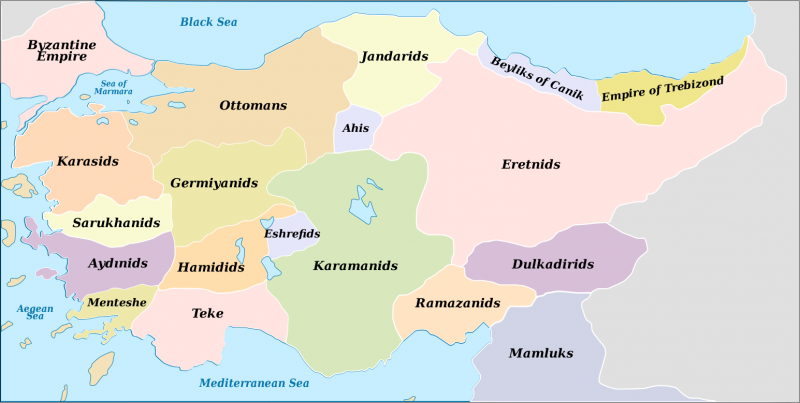
The map of 14th-century Anatolia resembles a shattered pot. The Byzantines had lost nearly all their territory in Asia by this point to a myriad of beyliks, petty Turkish states formed around a warrior chieftain called a bey. Bands of Turks had been settling in the region in the centuries since the Battle of Manzikert, when a Turkish sultan won a smashing victory over the Byzantines.
This ilke worthy knyght hadde been also/ Somtyme with the lord of Palatye/ Agayn another hethen in Turkye,/ And everemoore he hadde a sovereyn prys.
This same worthy knight had also spent some time fighting under the lord of Palatia against another heathen in Turkey, and as always enjoyed a sterling reputation.
The lord of Palatia (modern Balat) was another title for the bey of Menteşe. Menteşe was on the western coast of Anatolia, and frequently at war with its neighbor Aydin. The bey himself was of course a Muslim, but he had earned the respect and sometimes friendship of the Christians, as for instance Chaucer’s knight. Why does Chaucer mention the reputation our knight had among the heathens? Should a good Christian knight care about such things?
There was already an old literary precedent of Christian warriors fighting for Muslim princes. The most famous was the Song of El Cid, in which the hero is called “Cid” (from the Arabic al-Sayyid, meaning “the lord”) by the Muslims in recognition of his knightly virtue. Chaucer’s knight is no strictly literary homage, however. Byzantines, Venetians, and Genoese alike fought side-by-side with the Turk when circumstances demanded. An ever-fluid pattern of alliances formed and re-formed: sometimes the Italian republics cooperated against the Turks, sometimes they fought each other and sought Turkish allies. The Turks themselves were always at war, and Christians would often make treaties with one side or another.
The bey of Aydin, a formidable man named Umur the Lion. He periodically collaborated with the Byzantines, sending military assistance to the emperor several times. Umur’s relations with the Latin Christians were less friendly: he often raided Genoese, Venetians, and Knights Hospitaller possessions in the Aegean. The Latins retaliated, at one point capturing Umur’s great port city Smyrna in the so-called Crusade of Smyrna. So whenever the bey of Menteşe went to war with Aydin, he became a potential ally of the Christians. He seems to have done this several times over the 14th century, reflecting the fluid state of Anatolia at the time.
It is impossible to say precisely when Chaucer’s knight would have been in Menteşe, or whether he was in fact fighting against the bey of Aydin. It was likely sometime in the 1360s, as he was already in the eastern Mediterranean at this time. What was he doing there?
Peter I of Cyprus
At Lyeys was he, and at Satalye,/ Whan they were wonne; and in the Grete See/ At many a noble arive hadde he be.
In all his journeys abroad, Chaucer’s knight spent the longest time in Cyprus, at the court of King Peter I. Peter was a man who lived according to the ideals of another time. Not of such a distant past that he was a ridiculous Don Quixote, but of far enough back that his ambitions were unattainable. For King Peter was the last of the true crusaders, a man who devoted his life and the resources of his kingdom to the cause.
Cyprus itself was the last of the Crusader States. Its kings had inherited the title of King of Jerusalem, and retreated to the island before the fall of Acre, the final crusader city to fall to the Muslims. In the seventy years since, Cyprus had maintained a desultory rearguard against the conquering Muslim armies. In reality, the kingdom was in a strange position. A lone Christian outpost surrounded in all directions by Muslim powers, it also stood between two great eras of eastern Mediterranean history: after the Crusades, but before the era of Ottoman domination.
The wars of Peter I prefigured those of the 15th to 17th centuries, in which Christian powers such as Venice or the Knights Hospitaller made constant war on the Ottomans from their various island enclaves. Yet Peter still depended on the residual crusading impulse among Western European knights to furnish the manpower for his expeditions. The existential menace of the Ottoman steamroller could not yet rally all of Christendom to his cause. Meanwhile, the world had very much changed since the First Crusade, which had descended on the fractured city-states of the Levant like a bolt from the blue. The Muslim world had become much more unified, making any lasting conquest much more difficult.
It was only the ambition and energy of Peter that gave him any success at all. For a full decade, he raised funds and troops for expeditions against nearby Muslim powers. Syria and Egypt were united under the powerful Mameluke sultan, the strongest single potentate of the eastern Mediterranean. The Turkish princes of Anatolia, on the other hand, were fractured and set against one another, making them a natural target.
Peter therefore set his sights on Teke for his first major expedition. This beylik lay to the northwest of Cyprus on the Anatolian coast, just east of Menteşe. Its capital was “Satalye,” or Attalia—modern Antalya. Peter captured the town in 1361 and held onto it for the next twelve years. It is possible that this is when Chaucer’s knight entered the service of the lord of Palatia: ater joining the Cypriots for the assault on Attalia, he got bored of garrison life and wandered off through Anatolia to find new employment. Eventually, he made his way back to Cyprus for his next adventure.
A Different Tramyssene?
Some scholars have speculated that Tramyssene was not Tlemcen, but in fact Termessos, an ancient city ruin a few miles from Attalia. The town circus could have been used as lists for jousting with Turkish cavaliers, in between bouts of open warfare. There is nothing more specific to indicate either way, but it is an intriguing possibility.
Chaucer specifically states that his knight slew each of his opponents when he took to the lists against them. Even one death in a medieval tourney was unusual; three would be far out of the ordinary—the object was not to kill, after all. Occasionally, however, both sides in an impending battle would agree to settle the matter by individual or small-group combat. At the Barbary Crusade in 1390 (likely after the General Prologue was written), for instance, the Christian besiegers of Mahdia were challenged by the Muslim defenders to select ten of their best men to fight ten of the best Muslims and settle the matter.
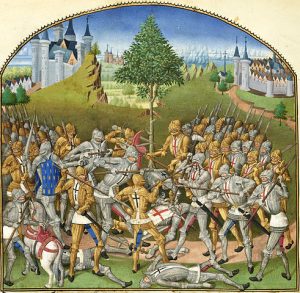
A similar, and much more famous, episode occurred between Christians during the Hundred Years’ War. The so-called Battle of the Thirty was an arranged combat between two sides in the War of Breton Succession (which became a proxy to, and was eventually subsumed by, the larger war). Each chose thirty men, who then battled it out en masse. The French-sponsored faction triumphed, but a quarter of the participants on both sides were killed.
While neither of these precisely fits Chaucer’s description of a joust, it shows how the forms of tournament were used to arrange lethal fights between two sides. The only mystery is where: Tlemcen, Termessos, or some other as-yet unknown place? Given the obscurity of Chaucer’s other references, it is still an open question.
The Alexandrian Crusade
At Alisaundre he was, when it was wonne.
Egypt had always been a major power in the Muslim world. It had long been identified as an objective of the crusaders, as its enormous manpower and agricultural productivity had made the crusader position in Jerusalem untenable. Such was its perceived importance that two named crusades (the Fifth and the Seventh) were launched against it. Now that Christendom had lost all of the Holy Land, crusading princes thought it wise to conquer Egypt before attempting the recapture Jerusalem.
Invading Egypt was like invading Russia: it could certainly be done, but depended on a lot going right and nothing going wrong—disaster was sure to follow otherwise. Misfortune had befallen the two previous crusades against Egypt, and the king of France himself was captured in the Seventh. But Peter was undaunted, so in 1362 he set off for Europe to recruit troops and raise funds for what would be known as the Alexandrian Crusade. A large number of European knights and Venetian ships assembled in Rhodes, and in 1365 they set sail.
The expedition started out successfully. The crusaders sacked Alexandria and took immense quantities of loot. This sated most of the participants, however, and no one but Peter showed any interest in carrying on to Cairo. The army dithered in the city for a few days, which gave the sultan of Egypt time to prepare a counter-offensive. When news arrived of a Mameluke army approaching, the entire host packed up the booty and set sail. The chagrined and disappointed king had no choice but to return to Cyprus with them.
Raiding In The Mediterranean
The dozen or so galleys which had appeared on the horizon that morning rapidly draw closer to shore. The waves help propel them the final stretch, and they rush onto the beach with a scraping thud.
Men hop over the gunwales and ramps are lowered, down which grooms lead a steady stream of horses down to the beach. Groups of crossbowmen dash up to the surrounding hilltops while teams of men implant palisades around a sizable part of the beach. After some time, cavalry patrols set off to get a look at the countryside and maybe do some foraging. Everyone not busy securing the beach is helping unload supplies from the ships, which continues past sundown.
The next day they set off, seizing an isolated village that scouts identified the day before. This will be their base of operations for the next week as they raid more villages and sack a few mid-sized towns. Finally, their commander makes the decision to leave. Everyone hauls their accumulated loot from the village down to the shore. After a full day of loading, they finally set sail once more.
Two years after his abortive invasion of Egypt, Peter had gathered another army. He still had a large body of knights in his service, and vowed to take the fight to the infidels once more before they returned home. His first target was Tripoli (in Lebanon, not Libya), which he sacked before ravaging the countryside. He then continued on in similar manner for the rest of the campaigning season, pillaging the Syrian and Cilician coasts. Chaucer’s knight was with him:
At Lyeys was he, and at Satalye/ Whan they were wonne, and in the Grete See/ At many a noble arive hadde he be.
The Great Sea is the Mediterranean, more specifically the eastern part between Sicily and the Levant. What is it exactly that Chaucer says his knight is doing there? An arive is another technical term, from the French for debarkation from a ship. In this context, it refers specifically to the debarkation of a military force: a coastal raid.
Among the towns Peter attacked was Lajazzo, or Lyeys, in Cilicia. His men captured and plundered the city but failed to seize the citadel, eventually forcing them to withdraw. Why did Chaucer mention Lajazzo at all if it was not a resounding victory?
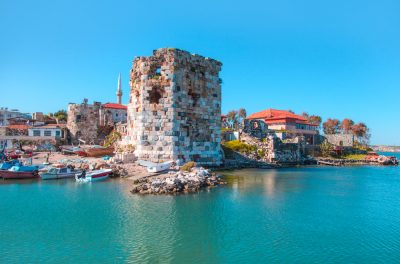
Today, Lajazzo is the small, seaside town of Yumurtalik. In the Middle Ages, it was a well-known terminus of the Silk Road, famous as the port by which Marco Polo entered Asia. Silk, spices, and other fine things flowed through here across the Mediterranean. News of Lajazzo’s capture, however fleeting, would have certainly made its way to England.
Back Home
The Hundred Years’ War resumed in 1369 and lasted continuously for the next twenty years. After crusading with Peter I, the knight would have presumably returned to England and France. Chaucer began writing the Canterbury Tales sometime around 1387, and it occupied him for the rest of his life. If the General Prologue was written first, Chaucer’s knight would have been just returning from the war.
This would be an unusual period for the knight, twenty years spent only in France and England. For someone who traveled so far and wide, it is remarkable how his journeys were compressed into the few years of breaks in the fighting. By looking at how the truces align with historical events, we come up with a fairly good guess at the itinerary Chaucer’s knight took. There is still plenty of uncertainty: the knight could have traveled to Prussia or Turkey any time during the last few decades before 1389, when fighting in France was more or less at a standstill.
The Man Who Was Chaucer’s Knight
Which brings us back to the question of the identity of Chaucer’s knight. Was he in fact based on a real person, or an idealized composite of all the adventurous knights Chaucer had encountered throughout his career?
Barring some outstanding discovery in an archive, it is impossible to say for sure. If the knight was a real person, it is highly likely he was associated with Henry, Duke of Lancaster. The duke was present in two of the three theaters the knight fought in abroad, and was a major participant in the Hundred Years’ War. Henry died early in 1361, the year after the Peace of Brétigny ended the first phase of the Hundred Years’ War. If the knight was part of the duke’s household, he would have narrowly had enough time to reach Cyprus before the expedition against Attalia, and would be free for the rest of the decade to adventure in the eastern Mediterranean.
It is also possible that he was not part of Henry’s personal retinue, but was a feudal levy who accompanied his lord on his missions abroad. The fact that he stayed much longer in Prussia than Henry did suggests as much. In any event, the logical progression to the knight’s career—participating in momentous events abroad during breaks in the war, where English knights were known to be present—suggests at the very least that he was not intended to be an immaculate idealization of chivalry. Although he was a verray parfit, gentil knyght, he was a flesh-and-blood embodiment of those ideals, similar to actual men Chaucer knew.
The knight’s career would have spanned about 45 years by the time Chaucer began writing the Canterbury Tales. If Chaucer’s knight was indeed a squire in the opening vignette (between 14 and 20 years of age), he would be in his 60s by the time of writing. It was by no means uncommon for men to keep fighting at that age, but not much beyond. Chaucer’s description calls to mind the image of a weary old man returning home from a hard life in the saddle, making one last pilgrimage to set his soul aright before settling into retirement. We can only wonder if Chaucer had one particular such man in mind.
A Knight Turned Upside Down
Terry Jones, the Monty Python member, wrote a bomb-throwing revisionist history titled Chaucer’s Knight, arguing that the character was the opposite of everything he is made out to be. Jones paints a picture of a world that had long grown tired of crusades, and that viewed any sort of Christian adventurism with a cynical eye. He describes Chaucer’s knight as a mercenary, a simple sword-for-hire too rough to even keep a clean outfit. All of his displays of chivalry were meant to be understood as satire: the ridiculous trappings of a bygone era whose ideals were belied by the grubby reality of the present.
For whatever a flat assertion is worth, Mr. Jones was completely wrong (this may be explored in a future post). His case depends on reading insinuations into the events that the most honorable members of English society participated in: for the knight to be understood as a villainous rapscallion, Chaucer would have to indict the entire knightly class, including many of his intimates. The world was certainly changing and had left certain ideals behind, but that simply meant the meaning of chivalry had changed; nowhere in his works does Chaucer give any sign of being a cynic who wholesale denied the value of a worthy fighting man.
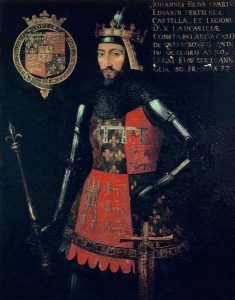
A single historical episode illustrates the attitudes of the time: in 1373, Chaucer’s brother-in-law and friend, John of Gaunt, undertook a great chevauchée. His army traveled south from Calais through eastern France, before cutting west to end at English-occupied Bordeaux. The purpose of the expedition was to completely demoralize the French: the English destroyed farms, sacked towns, and scattered defenders. The participants were greeted as heroes on their return to England, although John of Gaunt’s reputation suffered—not because of what he had done, but because he failed to achieve any decisive victory over the French. Against this popular reaction to a campaign of terror, it is impossible that any slight ambiguities in Chaucer’s description of the knight was meant to impugn his character.
Nevertheless, Chaucer’s Knight was an enjoyable book in my recollection (it has been about ten years), and it forces the reader to think about many details that would otherwise slip by.
Three Continents and the Great Sea
Chaucer’s knight traveled a minimum of ten thousand miles during his time away from England and France. He visited at least twelve different lands and met countless monarchs, potentates, and high officials. A close look at the man’s journeys gives us an incredible view of what this world looked like. A study of his backstory fills out a lively portrait of the contemporary world.
The 14th century was one of astonishing calamity and change. The devastation of the Hundred Years’ War spilled over into adjoining countries and upset the social fabric of all of Western Europe. In the midst of all this, the Black Death struck, dealing the continent another blow from which it would struggle to recover. But amidst this upheaval was ferment: the world was changing fast, driven as much by human ingenuity as by natural disaster. Societies and governments were abandoning feudal customs, scholars were reviving ancient learning, and poets and writers were exploring new forms.
Chaucer himself was a part of this change, playing an active role in the pivotal events of the era. A sharp observer of humanity, he was better-positioned than anyone to see what was going on, if not necessarily understand the momentous change. It should be no surprise, then, that Chaucer’s knight gives us a wonderful sense of the age, both as a creation of the new genius sweeping the Western world and as a tour guide to its complexity.
